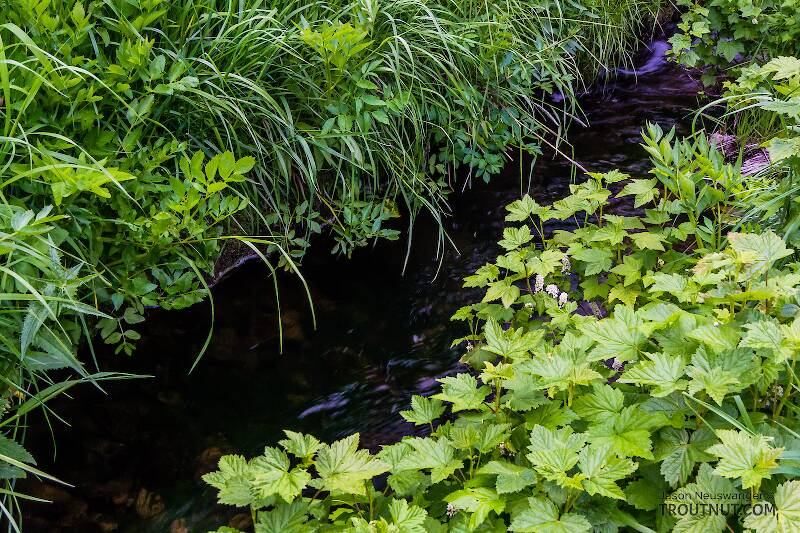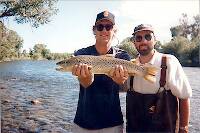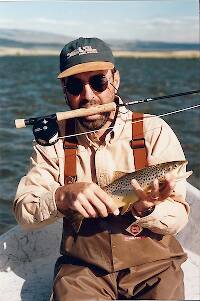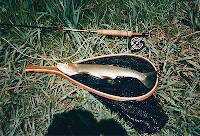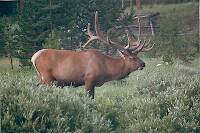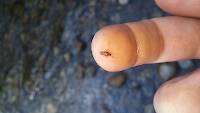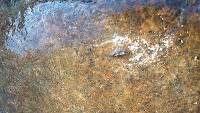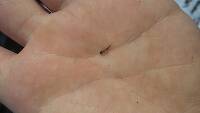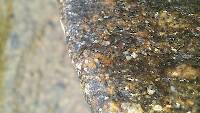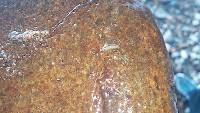
Blue-winged Olives
Baetis
Tiny Baetis mayflies are perhaps the most commonly encountered and imitated by anglers on all American trout streams due to their great abundance, widespread distribution, and trout-friendly emergence habits.
Featured on the forum

With a bit of help from the microscope, this specimen keys clearly and unsurprisingly to Hydropsyche.

Troutnut is a project started in 2003 by salmonid ecologist Jason "Troutnut" Neuswanger to help anglers and
fly tyers unabashedly embrace the entomological side of the sport. Learn more about Troutnut or
support the project for an enhanced experience here.
Psyfly on Oct 13, 2007October 13th, 2007, 6:50 am EDT
All photographers out there. What is the best lighting source for photographing fly imitations? I've been messing around with variations and nothing works as well as I would like it. Being and novice with photography, any help would be great.
"If I might be judge, God never did make a more calm,quiet, innocent recreation than angling" Isaac Walton
www.tierneysflies.com
www.tierneysflies.com
Troutnut on Oct 13, 2007October 13th, 2007, 5:46 pm EDT
I use the Canon MT-24EX macro flash using cross-polarization to cut down on glare from the flash. It's the same setup I use for bugs. It's expensive, but I think it is the best.
Jason Neuswanger, Ph.D.
Troutnut and salmonid ecologist
Troutnut and salmonid ecologist
Shawnny3 on Oct 14, 2007October 14th, 2007, 2:28 am EDT
Not that I know anywhere near as much as Jason does about this stuff, but my wife and I have been figuring out for awhile how to take pictures of artificials and we've come up with a set-up we like.
The first thing you have to figure out is how much money you want to spend. If you're just looking to put together an amateur studio to take a few shots of things you tied up, then you can check out some do-it-yourself sites with simple Google searches. If you want to take photos of the quality Jason does, then you're talking about investing at least a few grand in really nice lenses and lights (the macro flash he uses is extremely not-cheap, for example). You'll have to do some research and find out what the best set-up is for the cash you're willing to spend.
My flies are artistic creations and are a bit different to photograph than regular fishing flies, but here's how we do it: We use a lighting tent and two (though we'd like to have three) studio lights. We manipulate background colors by positioning acrylic and felt as desired, and play with lighting positions ad nauseum until we get it right. Having a digital camera makes this kind of playing around 100 times easier (we have the camera hooked up directly to the computer while we're snapping photos). The learning curve with a digital set-up is so much steeper than with a film camera that it is impossible to overstate. If you don't already know a ton about photography and can afford it, GO DIGITAL. Even if you think you can't afford it, go digital anyway! To learn how to get consistently high-level results, you will spend more money on film and developing costs than you will buying a nice digital camera. It's a no-brainer.
If you're having problems with the lighting sucking, you need to use professional lighting of some sort - the difference is tremendous. Controlling lighting is the single most difficult thing to learn, so make sure you understand how and when to manually override the default settings on your camera. The next most important consideration is the lens - you must have a good macro lens to make good photos of flies even possible. Finally, you have to be working from a tripod and be doing everything you can to minimize camera shake (using a timer, cable release, or remote release, keeping kids from stomping around the room while you're photographing, etc.).
We don't use the polarizing filters Jason suggests, but on his recommendation we're planning on trying them soon.
Hope this helps,
Shawn
The first thing you have to figure out is how much money you want to spend. If you're just looking to put together an amateur studio to take a few shots of things you tied up, then you can check out some do-it-yourself sites with simple Google searches. If you want to take photos of the quality Jason does, then you're talking about investing at least a few grand in really nice lenses and lights (the macro flash he uses is extremely not-cheap, for example). You'll have to do some research and find out what the best set-up is for the cash you're willing to spend.
My flies are artistic creations and are a bit different to photograph than regular fishing flies, but here's how we do it: We use a lighting tent and two (though we'd like to have three) studio lights. We manipulate background colors by positioning acrylic and felt as desired, and play with lighting positions ad nauseum until we get it right. Having a digital camera makes this kind of playing around 100 times easier (we have the camera hooked up directly to the computer while we're snapping photos). The learning curve with a digital set-up is so much steeper than with a film camera that it is impossible to overstate. If you don't already know a ton about photography and can afford it, GO DIGITAL. Even if you think you can't afford it, go digital anyway! To learn how to get consistently high-level results, you will spend more money on film and developing costs than you will buying a nice digital camera. It's a no-brainer.
If you're having problems with the lighting sucking, you need to use professional lighting of some sort - the difference is tremendous. Controlling lighting is the single most difficult thing to learn, so make sure you understand how and when to manually override the default settings on your camera. The next most important consideration is the lens - you must have a good macro lens to make good photos of flies even possible. Finally, you have to be working from a tripod and be doing everything you can to minimize camera shake (using a timer, cable release, or remote release, keeping kids from stomping around the room while you're photographing, etc.).
We don't use the polarizing filters Jason suggests, but on his recommendation we're planning on trying them soon.
Hope this helps,
Shawn
Jewelry-Quality Artistic Salmon Flies, by Shawn Davis
www.davisflydesigns.com
www.davisflydesigns.com
Psyfly on Oct 14, 2007October 14th, 2007, 5:01 am EDT
OK, Great. What's a studio light? Where can I find them? I have a lot to learn but will do things piecemeal until I get it right. Thanks for the great responses.
"If I might be judge, God never did make a more calm,quiet, innocent recreation than angling" Isaac Walton
www.tierneysflies.com
www.tierneysflies.com
JOHNW on Dec 22, 2013December 22nd, 2013, 4:14 pm EST
Psyfly,
If a budget is your issue studio lights will be tough. A simple but effective altenative is to make your own soft box. Plans abound but can be as simple as cutting the sides out of a cardboard box leaving a skeleton and then covering the openings with a transluCent material. Using very inexspensive clamp on reflector type. shop lights shining on the outside of the box. You end up with nice even light diffused around your items. By altering the color of the material you can completely change the effect and back drops are as easy as a sheet of paper in the back of the box.
About as cheap as you can get for a photo accessory and very utilitarian.
If a budget is your issue studio lights will be tough. A simple but effective altenative is to make your own soft box. Plans abound but can be as simple as cutting the sides out of a cardboard box leaving a skeleton and then covering the openings with a transluCent material. Using very inexspensive clamp on reflector type. shop lights shining on the outside of the box. You end up with nice even light diffused around your items. By altering the color of the material you can completely change the effect and back drops are as easy as a sheet of paper in the back of the box.
About as cheap as you can get for a photo accessory and very utilitarian.
"old habits are hard to kill once you have gray in your beard" -Old Red Barn
Quick Reply
Related Discussions
Topic
Replies
Last Reply
1
Sep 24, 2011
by Troutnut
by Troutnut
1
Nov 27, 2008
by Chris_3g
by Chris_3g
2
May 19, 2007
by Troutnut
by Troutnut
3
Nov 25, 2006
by Troutnut
by Troutnut
1
Jun 12, 2010
by Jesse
by Jesse
3
Mar 22, 2015
by Pookie025
by Pookie025

